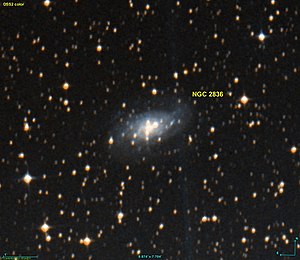NGC 2836
| Galaxy NGC 2836 |
|
|---|---|

|
|
| AladinLite | |
| Constellation | Keel of the ship |
|
Position equinox : J2000.0 , epoch : J2000.0 |
|
| Right ascension | 09 h 13 m 44.6 s |
| declination | -69 ° 20 ′ 05 ″ |
| Appearance | |
| Morphological type | SA (rs) bc: |
| Brightness (visual) | 11.8 mag |
| Brightness (B-band) | 12.6 mag |
| Angular expansion | 2.7 '× 2.0' |
| Position angle | 112 ° |
| Surface brightness | 13.5 mag / arcmin² |
| Physical data | |
| Redshift | 0.005654 +/- 0.000020 |
| Radial velocity | 1695 +/- 6 km / s |
|
Stroke distance v rad / H 0 |
(66 ± 5) · 10 6 ly (20.3 ± 1.4) Mpc |
| history | |
| discovery | John Herschel |
| Discovery date | January 29, 1835 |
| Catalog names | |
| NGC 2836 • PGC 26017 • ESO 061-003 • IRAS 09131-6907 • SGC 091308-6907.6 • | |
NGC 2836 is a spiral galaxy of Hubble type Sbc in the constellation Carina the southern sky . It is estimated to be 66 million light years away from the Milky Way and has a diameter of around 60,000 ly.
In the same area of the sky is the galaxy NGC 2822 .
The object was discovered by John Herschel on January 29, 1835 .
